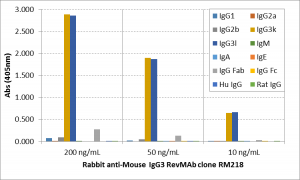anti-IgG3 (mouse) Rabbit Monoclonal (RM218)
| Code | Size | Price |
|---|
| REV-31-1094-00-C100 | 100 ug | £455.00 |
Quantity:
Prices exclude any Taxes / VAT
Overview
Antibody Isotype: Rabbit IgG
Antibody Clonality: Recombinant Antibody
Antibody Clone: RM218
Regulatory Status: RUO
Target Species: Mouse
Applications:
- Enzyme-Linked Immunosorbent Assay (ELISA)
- Fluorescence-activated cell sorting (FACS)
- Immunocytochemistry (ICC)
- Immunohistochemistry (IHC)
- Immunoprecipitation (IP)
- Western Blot (WB)
Shipping:
Blue Ice
Storage:
+4°C
Images
Documents
Further Information
Alternate Names/Synonyms:
Immunoglobulin G3
Concentration:
1 mg/ml
EClass:
32160000
Form (Short):
liquid
Formulation:
Liquid. 50% Glycerol/PBS with 1% BSA and 0.09% sodium azide.
Handling Advice:
Avoid freeze/thaw cycles.
Immunogen:
Mouse IgG3.
Long Description:
Recombinant Antibody. This antibody reacts to the Fab region of mouse IgG3. No cross reactivity with mouse IgG1, IgG2a, IgG2b, IgM, IgA, IgE, human IgG, or rat IgG. Applications: WB, IP, ICC, IHC, FACS, ELISA . Source: Rabbit. Liquid. 50% Glycerol/PBS with 1% BSA and 0.09% sodium azide. Immunoglobulin G (IgG), a monomer, is the predominant Ig class present in serum. Produced as part of the secondary immune response to an antigen, this class of immunoglobulin constitutes approximately 75% of total serum Ig. In mice there are four different IgG subclasses known, namely IgG1, IgG2a/c, IgG2b, and IgG3, which are determined by their respective C regions γ1, γ2a/c, γ2b, and γ3. The mutually exclusive occurrence of either IgG2a or IgG2c is determined by the genetic background of the mouse strain; however, both IgG2a and IgG2c are thought to have similar characteristics. Because of its relative abundance and excellent specificity toward antigens, IgG is the principle antibody used in immunological research and clinical diagnostics. This anti-mouse secondary antibody has well-characterized specificity for mouse IgG immunoglobulins and is useful in the detection, sorting or purification of its specified target. In general, secondary antibodies offer increased versatility enabling users to use many detection systems (e.g. HRP, AP, fluorescence). They can also provide greater sensitivity through signal amplification as multiple secondary antibodies can bind to a single primary antibody.
NCBI, Uniprot Number:
P03987
Package Type:
Vial
Product Description:
Immunoglobulin G (IgG), a monomer, is the predominant Ig class present in serum. Produced as part of the secondary immune response to an antigen, this class of immunoglobulin constitutes approximately 75% of total serum Ig. In mice there are four different IgG subclasses known, namely IgG1, IgG2a/c, IgG2b, and IgG3, which are determined by their respective C regions gamma1, gamma2a/c, gamma2b, and gamma3. The mutually exclusive occurrence of either IgG2a or IgG2c is determined by the genetic background of the mouse strain; however, both IgG2a and IgG2c are thought to have similar characteristics. Because of its relative abundance and excellent specificity toward antigens, IgG is the principle antibody used in immunological research and clinical diagnostics. This anti-mouse secondary antibody has well-characterized specificity for mouse IgG immunoglobulins and is useful in the detection, sorting or purification of its specified target. In general, secondary antibodies offer increased versatility enabling users to use many detection systems (e.g. HRP, AP, fluorescence). They can also provide greater sensitivity through signal amplification as multiple secondary antibodies can bind to a single primary antibody.
Purity:
Protein A purified.
Source / Host:
Rabbit
Specificity:
This antibody reacts to the Fab region of mouse IgG3. No cross reactivity with mouse IgG1, IgG2a, IgG2b, IgM, IgA, IgE, human IgG, or rat IgG.
Transportation:
Non-hazardous
UNSPSC Category:
Secondary Antibodies
UNSPSC Number:
12352203
Use & Stability:
Stable for at least 1 year after receipt when stored at -20°C.



